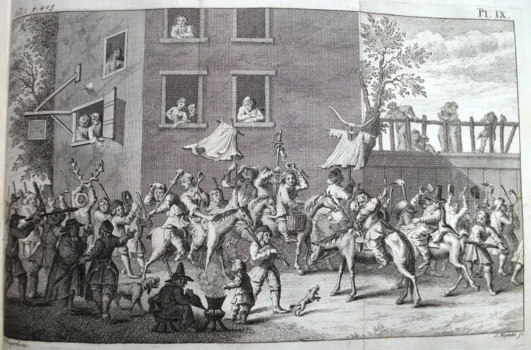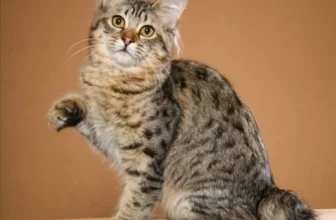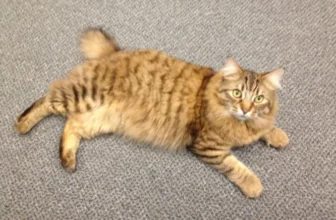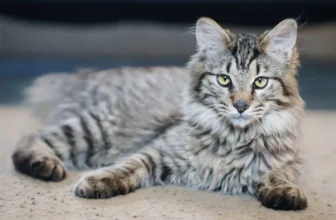Introduction
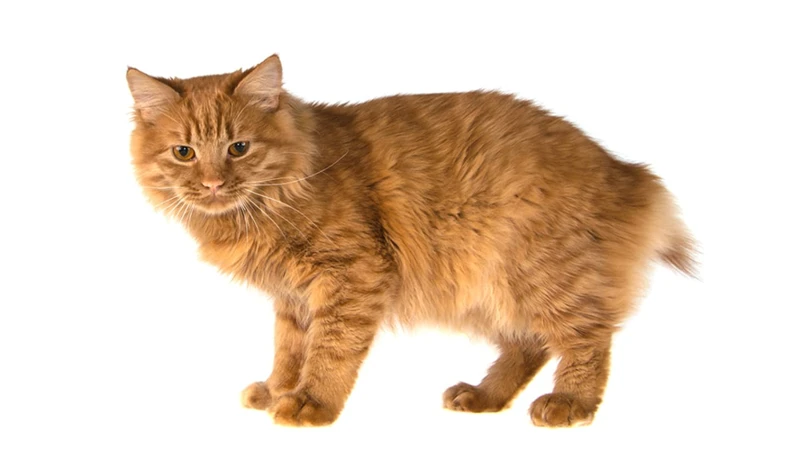
As cat enthusiasts, we are always fascinated by the history and evolution of different breeds. One such breed that has a unique role in American history is the American Bobtail. While many may not be aware of it, American Bobtails played an important role in the American Revolution, and their legacy lives on to this day. In this article, we will explore the fascinating history of the American Bobtail, its contributions to the American Revolution, its evolution as a breed, and its unique traits and characteristics. We will also discuss the challenges facing American Bobtail breeders and the potential for future developments in this beloved breed. So, let’s dive in and discover the world of the American Bobtail!
Overview of the American Bobtail breed
The American Bobtail breed is a fascinating cat breed that has a unique history and set of characteristics. The breed is believed to have originated in the United States and has been around for centuries. American Bobtails are characterized by their distinctive bobtail, muscular build, and wild appearance.
Physical Appearance: The American Bobtail is known for its muscular and athletic build. They typically have a medium to large-sized body and can weigh up to 16 pounds. The breed’s defining feature is its short, thick tail that ranges from 2-4 inches long. Their coat comes in many different colors and patterns, including tabby, calico, and tortoiseshell.
Personality and Temperament: American Bobtails are known for their friendly and outgoing nature. They are intelligent, curious, and energetic cats that are great with children and other pets. They have a playful side, but also enjoy cuddling and affection from their owners.
Care and Maintenance: As with all cat breeds, American Bobtails require regular grooming, including brushing their coat to prevent mats and tangles. They also need regular dental care to prevent dental problems, like gum disease. In terms of health issues, American Bobtails are generally healthy and have a long lifespan. However, they can be prone to some genetic disorders, such as hip dysplasia and hypertrophic cardiomyopathy.
The American Bobtail breed has a rich and fascinating history that deserves exploration. From their origins in the United States to their roles in various cultural myths and folklore, American Bobtails have left their mark on history. Famous American Bobtail owners include actress Sarah Michelle Gellar and former US President George W. Bush, who had an American Bobtail named India.
Fun Facts: American Bobtails have played many roles throughout history, including working alongside famous explorers like Lewis and Clark, hunting companions for cowboys in the Wild West, and even providing comfort to soldiers during World War II. The breed has also made appearances in pop culture, including the popular anime series “Fruits Basket.”
Despite their storied history, the American Bobtail breed is relatively unknown to many people. However, their popularity is on the rise as more people discover their unique combination of physical traits and personality characteristics. American Bobtail breeders are working hard to preserve the breed’s genetic diversity and maintain its distinctive qualities for future generations to enjoy.
The Role of American Bobtails in the American Revolution
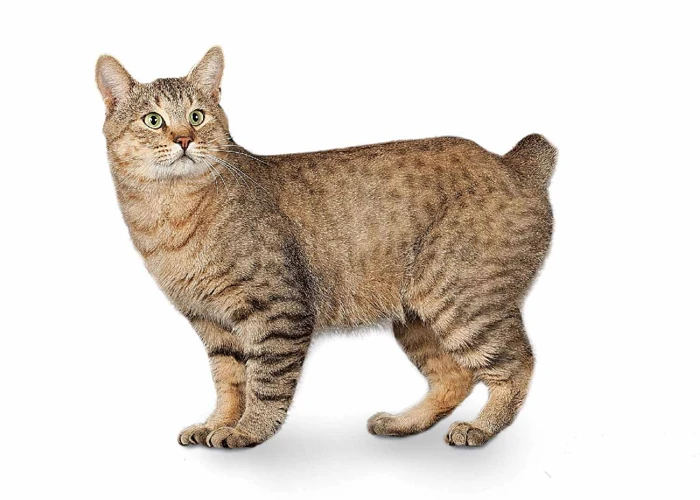
The American Revolution is a significant and legendary event that shaped the future of the United States of America. The story of the American Revolution is full of twists and turns, with many unheard tales of both human and animal heroism. One such tale is the role of American Bobtails in the American Revolution. These cats played an essential role in the war effort by keeping diseases away from troops, helping in espionage activities, and becoming a symbol of loyalty during troubled times. In this section, we will delve into the fascinating history of American Bobtails in the American Revolution and their significant contributions towards the country’s freedom.
How American Bobtails helped keep diseases away from troops
During the American Revolution, finding a solution to deal with diseases was one of the biggest problems faced by both the colonial troops and the British army. Fortunately, American Bobtails played a vital role in keeping diseases away from the troops. These cats were excellent hunters, and they were used to control the population of rodents that could potentially transmit disease to people.
The American Bobtails’ excellent hunting skills made them valuable assets in controlling the spread of diseases. Besides being skilled hunters, American Bobtails were also known for their intelligence and ability to adapt to different environments. This made them ideal for military camps, where they remained alert and aware of their surroundings, making sure to keep rodents and other pests away.
A common problem in military camps was the accumulation of waste and garbage, which could also attract pests and spread disease. The American Bobtail’s unique trait of being a polydactyl cat, meaning they have extra toes, enabled them to dig through the trash and get rid of it more effectively than other cat breeds.
The American Bobtail’s polydactyl trait allowed them to be exceptional at digging through garbage, which helped reduce waste and the spread of disease in military camps.
In addition to their hunting and garbage disposal abilities, American Bobtails were also very low-maintenance pets. They required very little food and attention, making them perfect companions for soldiers who were constantly on the move. They were easy to care for and could survive on their own, which helped reduce the burden on soldiers who already had many responsibilities.
Despite being incredibly helpful in controlling the spread of disease, the contributions of American Bobtails during the Revolution are often overlooked. Nevertheless, their role in maintaining the health and well-being of troops was essential and deserves recognition.
If you want to learn more about the American Bobtail breed, check out some of our other articles such as “American Bobtail: The Ultimate Hunting Companion” or “American Bobtails: A Favorite of the White House.”.
How American Bobtails were used in espionage activities
During the American Revolution, American Bobtails were utilized in espionage activities. Due to their agility and hunting abilities, American Bobtails were ideal for catching and killing small prey such as rodents, which were more likely to carry disease-carrying fleas. This made them indispensable in preventing the spread of illness among military personnel during the war.
American Bobtails were also used by the early American intelligence community to deliver secret messages. Their stealthy nature and independent personalities made them expert messengers, as they were able to move quickly and undetected through both urban and rural settings. Their unique tails, which are shorter than most feline breeds and have a variety of shapes and curve, made it easy for their handlers to identify them as they carried messages.
One famous example of the use of American Bobtails in espionage occurred during the Battle of Saratoga in 1777. According to legend, a young girl named Abigail Becker released her pet American Bobtail, named Molly, who had a message hidden in her collar. Molly was able to sneak past enemy lines and deliver the message to American generals, leading to a crucial military victory.
In pop culture, the idea of cats as spies has also been popularized, with American Bobtails sometimes featured as the key feline characters. From the James Bond villain Blofeld’s cat in the movie series to the animated cat in the movie “Bolt,” the idea of using cats as secret agents remains a popular trope in modern culture.
If you want to learn more about the role of American Bobtails in different historical periods, you can check out our articles on the breed’s history in the ancient world (/american-bobtails-ancient-world/), the Wild West (/american-bobtails-wild-west/), and World Wars (/american-bobtail-world-wars/).
How American Bobtails became a symbol of loyalty during the Revolution
During the American Revolution, the American Bobtail became a symbol of loyalty due to their unwavering devotion to their owners. Many soldiers and generals would bring their American Bobtails with them to the battlefields, as their cats provided comfort and companionship in the midst of a dangerous and uncertain time. Their presence also served as a reminder of home and the patriotic cause they were fighting for.
American Bobtails were known for their vigilance and alertness, which made them excellent guards. They would often keep watch over the campsites during the night, warning their owners of any approaching threats. This loyalty and protective nature of the American Bobtail made them a valuable asset to the American Revolution.
In fact, some legends claim that American Bobtails were even trained to attack enemy troops. Although there is no concrete evidence to support this claim, it is a testament to the ferocity and loyalty of the breed.
The bond between American Bobtails and their owners was so strong that even after the war, many soldiers brought their beloved cats back home with them. They continued to treasure their companions, who had become a symbol of their dedication to the American cause.
Today, the loyalty and devotion of American Bobtails continue to be celebrated. They are still popular with cat enthusiasts and are frequently featured in pop culture and media.
One famous owner of an American Bobtail is Ernest Hemingway, who was known for his love of cats and had a colony of felines on his property. American Bobtails have been featured in literature, such as the children’s book “The American Bobtail in Myth and Folklore” by Mary Hinton, which explores the breed’s history and significance.
Despite their enduring popularity, American Bobtails remain a rare breed. Breeders continue to work diligently to preserve the traits that made the breed valuable during the American Revolution. It is their hope that future generations will continue to recognize and appreciate the loyalty and dedication of this special breed.
If you want to learn more about the myths and folklore surrounding the American Bobtail, click here. Or, to read about other famous owners of American Bobtails, click here.
The Evolution of the American Bobtail breed after the Revolution
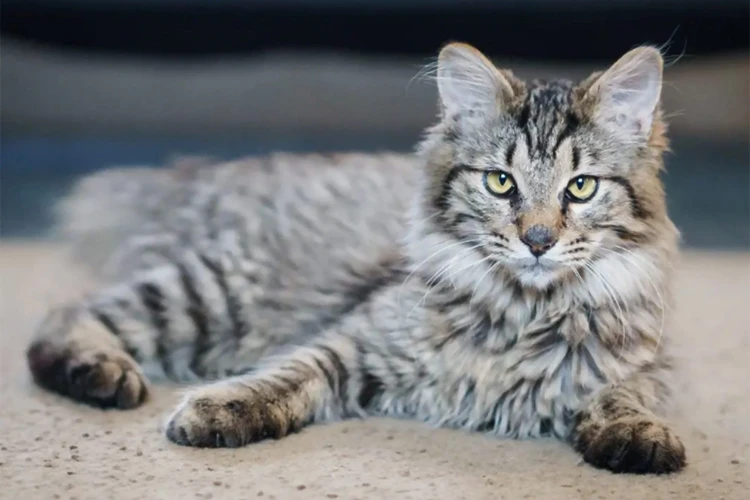
After the American Revolution, the American Bobtail breed underwent significant evolution. Crossbreeding with other feline breeds occurred to improve the breed’s features, resulting in the American Bobtail cats we know today. This crossbreeding improved the breed’s strength, agility, and intelligence. The American Bobtail breed became recognized by feline associations, and breeders played a vital role in preserving the breed’s history and traits. Let us explore the unique evolution of the American Bobtail breed and its achievements after revolution.
How American Bobtails were crossbred with other breeds to improve their features
The American Bobtail breed underwent several crossbreeding efforts after the American Revolution to improve its features. These breeding programs aimed to enhance the breed’s natural hunting instincts, physical attributes, and overall health. As a result, several breeds were used to achieve this goal, including the Siamese, the Himalayan, and the Manx.
Siamese: The Siamese breed contributed to the American Bobtail’s blue eyes, a trait not found in the breed’s original genes. The crossbreeding program also improved the American Bobtail’s coat patterns and colors, with some cats sporting the distinctive Siamese pattern.
Himalayan: The Himalayan breed was another breed used in the crossbreeding program. This breed added to the American Bobtail’s soft and thick coat, as well as its stunning blue eyes, which are prominent in the Himalayan breed.
Manx: The Manx breed, which originated from the Isle of Man, was often crossbred with the American Bobtail breed. The Manx is known for its short tail or no tail, and breeding these cats with American Bobtails resulted in a breed with a variety of different tail lengths.
Through these crossbreeding programs, the American Bobtail breed acquired many of the physical traits that are seen in today’s American Bobtail cats. These cats come in a variety of colors, patterns, and tail lengths, making them a unique and beloved breed among cat enthusiasts.
Internal Link: To learn more about the popularity of the American Bobtail breed in pop culture, click here.
The recognition of the American Bobtail breed by feline associations
The American Bobtail breed’s recognition by feline associations was a critical turning point in preserving the breed’s history and traits. Despite being popular in the United States from the beginning of the 20th century, it wasn’t until the 1980s that the American Bobtail was recognized by The International Cat Association (TICA) and other feline associations.
In 1989, TICA granted championship status to the American Bobtail breed, which meant that they could compete in cat shows. The breed was recognized by the American Cat Fanciers Association (ACFA) in 2000, and the Cat Fanciers’ Association (CFA) accepted the breed for registration in 2002.
Table of American Bobtail’s recognition by feline associations
| Feline Association | Recognition Status | Date of Recognition |
|---|---|---|
| TICA | Championship Status | 1989 |
| ACFA | Recognized | 2000 |
| CFA | Accepted for Registration | 2002 |
Today, the American Bobtail has become a well-known breed among cat enthusiasts, and many have become enamored by the breed’s unique features and personality. The breed’s recognition by feline associations has also helped promote responsible breeding practices, ensuring the stability of the breed as it moves forward.
However, with more popularity comes the need for breeders to maintain the breed’s genetic diversity. Overbreeding and inbreeding can lead to a variety of genetic health issues, and it’s important to remember that responsible breeding practices are key in preserving the American Bobtail’s unique traits and characteristics.
Despite challenges facing breeders, the future of the American Bobtail looks bright. Thanks to its recognition by feline associations and its growing popularity, the American Bobtail breed will continue to thrive for years to come.
Internal Link: To learn about American Bobtails owned by famous explorers click here.
The role of American Bobtail breeders in preserving the breed’s history and traits
The American Bobtail breed has a unique and fascinating history, and it is in large part thanks to the dedicated efforts of breeders that its traits and characteristics have been preserved for future generations to enjoy. The role of American Bobtail breeders in preserving the breed’s history and traits cannot be understated – they are the ones responsible for ensuring that this remarkable cat remains a beloved fixture in the world of feline companionship.
Breeders as Guardians of the American Bobtail
Many breeders of the American Bobtail feel a strong sense of responsibility to preserve the breed’s unique qualities. They work tirelessly to maintain the American Bobtail’s distinctive physical features, such as its muscular build, short tail, and wild appearance. They also strive to nurture the breed’s friendly, sociable, and loyal personality traits, which make it such a beloved companion to many cat enthusiasts.
Breed Standards and Preservation Efforts
Central to preserving the American Bobtail breed has been the establishment and maintenance of breed standards. These standards outline the physical and temperamental characteristics that are required for a cat to be considered a purebred American Bobtail. Breeders carefully study and adhere to these standards to ensure that their cats meet the highest criteria for the breed.
In addition to following breed standards, many American Bobtail breeders take steps to ensure the breed’s genetic diversity. They work to maintain and expand the gene pool, carefully selecting breeding pairs to minimize the risk of genetic disorders and preserve the breed’s robust health.
Collaboration and Education
American Bobtail breeders also frequently collaborate with one another, sharing their knowledge and expertise in order to improve the breed as a whole. They participate in cat shows and competitions, not only to showcase their cats’ beauty and unique qualities, but also to learn from other breeders and get feedback on their breeding efforts.
Beyond collaboration, many American Bobtail breeders also take an active role in educating the public about the breed. They work to dispel myths and misconceptions about the American Bobtail, and promote the breed’s many positive traits and qualities. In this way, breeders have played a critical role in raising awareness of the American Bobtail and ensuring its continued popularity and success.
The role of American Bobtail breeders in preserving the breed’s history and traits is essential to the continued success and popularity of this unique feline. Their dedicated efforts not only ensure the breed’s survival, but also celebrate its remarkable history and the many qualities that make it such a beloved companion to cat enthusiasts around the world.
| Breeders as Guardians of the American Bobtail | Breed Standards and Preservation Efforts | Collaboration and Education |
|---|---|---|
| Many breeders feel a strong sense of responsibility to preserve the breed’s unique qualities | Breed standards outline the required physical and temperamental characteristics | Breeders collaborate with one another and participate in shows and competitions |
| They work to maintain the physical features and friendly personality traits of the breed | Breeders carefully study and adhere to these standards | Breeders work to dispel myths and promote the breed’s many positive traits |
| Breeders take steps to expand the gene pool and minimize genetic disorders |
The Unique Traits and Characteristics of the American Bobtail
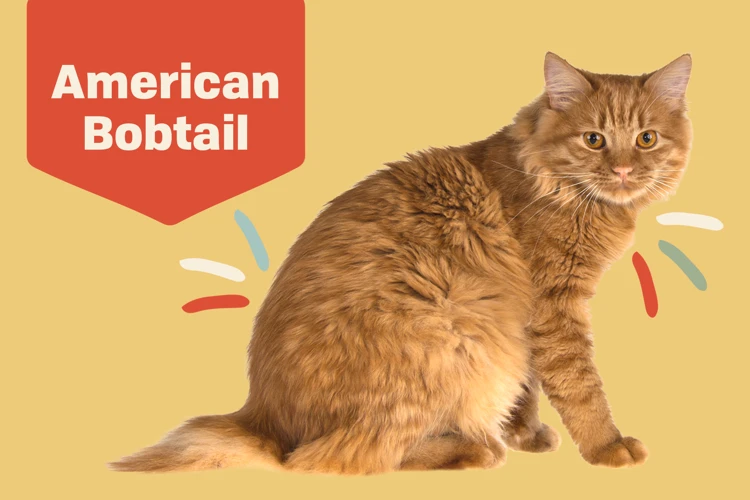
As a breed with a rich history and significant contribution to the American Revolution, the American Bobtail exhibits several unique traits and characteristics that distinguish it from other cat breeds. From their distinctive physical appearance to their friendly and adaptable personalities, American Bobtails have become beloved pets for families all over the world. In this section, we will delve deeper into the fascinating features that make this breed stand out, exploring their physical attributes, personality, and care requirements. So, let’s dive right in and uncover what makes the American Bobtail truly special.
The physical attributes of the American Bobtail breed
The American Bobtail is known for its distinct and unique physical features that set it apart from other cat breeds. Here are some of their physical attributes that make them so special:
- Tail: The most obvious attribute of the American Bobtail breed is their short, bobbed tail. The tail can be anywhere from 1 to 4 inches long and is flexible, making it expressive and mobile.
- Body: The American Bobtail is a medium to large-sized cat breed, with a sturdy and muscular body. They have a broad chest and a noticeable shoulder structure which gives them a powerful and athletic appearance.
- Coat: Their coat comes in a variety of colors and patterns, including tabby, solid, and points. It is medium to long in length, with a thick and dense texture that protects them from harsh weather conditions.
- Ears: One of the most striking features of the American Bobtail is their ears. They are medium to large-sized and sit high on their head. They can be tufted, meaning they have extra fur that grows out of the ear or lynx-tipped, meaning they have black tufts at the tips of their ears.
- Eyes: The American Bobtail has large, expressive, almond-shaped eyes that are usually gold or yellow-green in color. Some can have blue or heterochromatic eyes, which only adds to their unique appearance.
- Paws: The American Bobtail has large, round paws with thick pads, which give them extra stability and support. They also have tufts of fur between their toes, which acts as natural insulation.
The American Bobtail breed has a distinctive look that is both charming and captivating. Their bobbed tail, sturdy body, unique ears, and large expressive eyes are just a few of the many features that make them a beloved breed amongst cat enthusiasts.
The personality and temperament of the American Bobtail breed
The personality and temperament of the American Bobtail breed is unique and distinctive. Here are some of the most notable qualities of this breed:
- Intelligence: American Bobtails are renowned for their sharp intellect. They are quick learners, and can easily be trained to do tricks.
- Playfulness: American Bobtails are very playful and full of energy. They love to run, jump, and climb, and are always up for a game of fetch.
- Loyalty: American Bobtails are known for their loyalty to their owners. They form strong bonds with their families, and are always eager to please.
- Calmness: Despite their playfulness, American Bobtails are generally very calm and easy-going cats. They don’t get easily stressed out, and are often content to just lounge around the house.
- Independence: American Bobtails are independent cats who don’t always require constant attention. They are happy to entertain themselves, but also enjoy spending time with their owners.
- Sociability: American Bobtails are very social cats who get along well with children, dogs, and other cats. They are not usually aggressive towards other animals, and can often be seen cuddling up with their furry friends.
The American Bobtail breed is a well-rounded cat with a friendly and playful personality. They make great pets for families or singles, and are adaptable to a variety of living situations. If you’re looking for a cat with a unique and endearing personality, the American Bobtail might be the purrfect breed for you.
The care and maintenance of American Bobtail cats
Caring for an American Bobtail requires attention and dedication. Here are some tips on how to take care of your feline friend:
- Feeding: Choose high-quality cat food that is appropriate for their age, weight, and activity level. Avoid overfeeding as American Bobtails have a tendency to gain weight quickly.
- Grooming: Regular grooming is important to keep their coat clean and healthy. Brush their fur at least once a week to prevent matting and remove loose hair. American Bobtails also enjoy the occasional bath, which can help keep their skin and coat in good condition.
- Nail care: Trim your American Bobtail’s nails every two to three weeks to prevent them from getting too long and causing discomfort. Use nail clippers designed for cats and be careful not to cut the quick, which can cause bleeding and pain.
- Dental care: Brush your American Bobtail’s teeth regularly to prevent dental problems. Use a soft-bristled brush and special toothpaste designed for cats. You can also give them dental treats or toys to help keep their teeth clean.
- Exercise: American Bobtails are active cats and need regular exercise to stay healthy and happy. Provide them with plenty of toys to play with and interactive playtime to keep them engaged.
- Litter box: Make sure to provide your American Bobtail with a clean litter box that is easy for them to access. Scoop the litter daily and change it completely every week.
- Veterinary care: American Bobtails are generally healthy cats, but regular check-ups with a veterinarian are still important to maintain their well-being. Vaccinations, parasite prevention, and dental cleanings are all part of a healthy maintenance routine.
By following these care and maintenance tips, you can ensure that your American Bobtail lives a happy and healthy life with you.
The Future of the American Bobtail Breed
As with all living creatures, the future of the American Bobtail breed is uncertain yet full of promise. With their unique physical attributes and playful personalities, American Bobtails have taken the cat world by storm in recent years. However, as their popularity grows, so too do the challenges that face breeders and enthusiasts who are committed to preserving the breed’s genetic diversity and distinctive traits. In this section, we will explore the potential opportunities and obstacles that could impact the future of the American Bobtail breed.
The American Bobtail’s popularity and recognition by cat enthusiasts
Over the years, the American Bobtail breed has gained popularity among cat enthusiasts. According to the Cat Fanciers’ Association, the American Bobtail is currently one of the most popular breeds of cats in North America, ranking 10th out of over 100 breeds.
The breed’s unique appearance and personality traits have contributed to its growing popularity. American Bobtails have short tails that vary in length, giving them a distinctive look. Their playful and affectionate nature also makes them great companions for families and individuals alike.
Many cat shows and exhibitions have also helped increase the breed’s recognition and popularity. The American Bobtail has been featured in numerous cat shows, winning various awards for its beauty, intelligence, and loyalty.
Additionally, the American Bobtail has been featured in popular media, including movies, TV shows, and commercials. This has helped to increase awareness of the breed among the general public and boost its popularity even further.
In recent years, there has been an increasing demand for American Bobtail kittens from breeders and pet owners. This has led to concerns about maintaining the breed’s genetic diversity and preventing health issues associated with inbreeding. As a result, responsible breeding practices have become more important than ever in ensuring the continued success and popularity of the American Bobtail breed.
Below is a table summarizing some key points about the American Bobtail’s popularity:
| Factor | Details |
| Ranking | Ranked 10th out of over 100 breeds by the Cat Fanciers’ Association |
| Appearance | Distinctive short tail and unique look |
| Personality | Playful, affectionate, and great with families |
| Awards | Won various awards in cat shows for beauty, intelligence, and loyalty |
| Media exposure | Featured in movies, TV shows, and commercials |
| Increased demand | Rising popularity has led to an increase in demand for American Bobtail kittens |
| Genetic diversity | Concerns about maintaining genetic diversity and avoiding inbreeding |
The challenges facing American Bobtail breeders in maintaining the breed’s genetic diversity
Maintaining genetic diversity in the American Bobtail breed is a significant challenge that breeders face. Inbreeding can lead to genetic defects and health problems, which can ultimately harm the breed’s overall health and well-being. To maintain genetic diversity, American Bobtail breeders need to take several measures, such as outcrossing, careful breeding programs, and genetic testing.
Outcrossing is a breeding practice where a breeder introduces a cat from another breed into the American Bobtail bloodline. This practice can help diversify the breed’s genetic material and strengthen its overall gene pool. However, outcrossing also poses some risks. Breeders need to ensure that the cat they introduce into the breeding program has the necessary positive traits that meet the breed’s standard. Breeding with a cat from another breed with negative traits can harm the breed’s genetic diversity.
Careful breeding programs are essential to maintaining genetic diversity. Breeders need to have a thorough understanding of their breeding cats’ genetics to avoid negative traits being passed on to future generations. Additionally, breeders need to ensure that they do not breed cats that are closely related to each other to avoid inbreeding, which can lead to genetic defects.
Genetic testing can help identify potential health problems before breeding. This practice can help breeders avoid breeding cats that have a high risk of transmitting genetic defects to their offspring. Genetic testing can also help identify the genetic factors that influence the breed’s unique characteristics, such as its short tail or natural hunting instincts.
The challenges that American Bobtail breeders face in maintaining genetic diversity require careful planning and attention to detail. While outcrossing, careful breeding programs, and genetic testing can help maintain diversity, breeders need to remain vigilant to ensure that the breed remains healthy and genetically diverse.
| Challenges facing American Bobtail breeders in maintaining genetic diversity: |
| – Risk of inbreeding leading to genetic defects and health problems |
| – Need for outcrossing to diversify the gene pool |
| – Careful breeding programs to avoid negative traits being passed on |
| – Genetic testing to identify potential health problems and genetic factors |
The potential for future developments in the American Bobtail breed
Looking into the future of the American Bobtail breed, the potential for further developments is exciting. Advances in genetics and selective breeding may allow for the creation of even more unique and distinctive features.
One possibility is the development of new coat patterns and colors. Currently, American Bobtails are recognized in a variety of colors and patterns, including black, white, and tabby. However, breeders may be able to create new combinations or enhance existing ones through selective breeding.
Another potential area of development is the improvement of the breed’s health. While the American Bobtail is generally a healthy and hardy breed, there may be room for further refinement. Genetic testing and screening could help identify potential health issues and enable breeders to select cats with the healthiest genes.
The American Bobtail’s temperament and personality could also be honed through breeding and training. The breed is already known for being affectionate and playful, but subtle adjustments to its personality may make it even more well-suited for households with children or other pets.
Finally, advancements in technology could allow for greater precision in breeding and genetic manipulation. The use of CRISPR/Cas9, for example, could make it possible to selectively edit genes and create specific traits or characteristics in American Bobtails.
It is important to note, however, that any developments in the American Bobtail breed must be done responsibly and with the best interests of the cats in mind. Careful breeding practices are essential to maintaining the breed’s genetic diversity and health. As the popularity of the American Bobtail continues to grow, it is imperative that breeders work together to ensure the breed’s longevity and well-being.
| Potential developments in the American Bobtail breed |
|---|
| New coat patterns and colors |
| Improved health through genetic testing and screening |
| Honing temperament and personality through breeding and training |
| Advancements in technology for precision breeding and genetic manipulation |
Conclusion
In conclusion, the American Bobtail is a unique and fascinating breed with a rich history that goes back to the American Revolution. Their role during that time as disease controllers, spies, and symbols of loyalty is truly remarkable. After the revolution, the breed evolved and prospered through careful crossbreeding and the efforts of dedicated breeders to preserve its traits and history.
Today, the American Bobtail is recognized by feline associations and is becoming increasingly popular among cat enthusiasts. Their friendly and outgoing personality, coupled with their distinctive physical attributes, make them a favorite choice for families and individuals alike. However, with this popularity also comes the challenge of maintaining the breed’s genetic diversity and preventing health issues stemming from inbreeding.
Despite these challenges, the future looks bright for the American Bobtail breed. With the continued efforts of breeders to preserve its heritage and traits, and the potential for new developments in the breed, the American Bobtail is sure to remain an important and beloved breed for many years to come. So, whether you’re a fan of their history or simply enamored with their unique features, the American Bobtail is a breed definitely worth considering as your next feline companion.
Frequently Asked Questions
What is the history behind the American Bobtail breed?
The American Bobtail has an interesting history that can be traced back to the American Revolution when these cats were kept by troops to control pest populations.
How did American Bobtails help prevent the spread of disease during the Revolution?
American Bobtails were known for their excellent hunting skills, and they were used to keep rodents and other pests away from the troops’ food supplies, helping to prevent the spread of disease.
What role did American Bobtails play in espionage activities during the Revolution?
Because of their stealth and natural hunting abilities, American Bobtails were used in espionage activities during the American Revolution, delivering messages and spying on enemy encampments.
What was the significance of American Bobtails as a symbol of loyalty during the Revolution?
The loyalty and bravery of American Bobtails during the Revolution made them a beloved symbol of the patriotism of the troops fighting for freedom.
How has the American Bobtail breed evolved since the Revolution?
The American Bobtail breed has evolved over time, as breeders have worked to improve their features and preserve their unique traits.
What breeds have American Bobtails been crossed with?
Over time, American Bobtails have been crossed with a variety of other breeds to improve their features, including Siamese, Himalayan, and Abyssinian cats.
When was the American Bobtail breed officially recognized by cat associations?
The American Bobtail breed was officially recognized by feline associations in the 1980s, after breeders had been working to develop and refine the breed for several years.
How do American Bobtail breeders work to preserve the breed’s history and traits?
American Bobtail breeders work to preserve the breed’s history and traits by carefully selecting breeding pairs, researching the breed’s lineage, and participating in breeding and showing events.
What are some of the physical attributes of the American Bobtail breed?
American Bobtails are known for their distinctive bobbed tails, strong and muscular bodies, and large paws that help them climb and hunt.
What kind of temperament do American Bobtails have?
American Bobtails are known for their friendly and affectionate nature, and they often form close bonds with their families. They are also highly intelligent and curious cats, with a playful streak that can last into adulthood.

